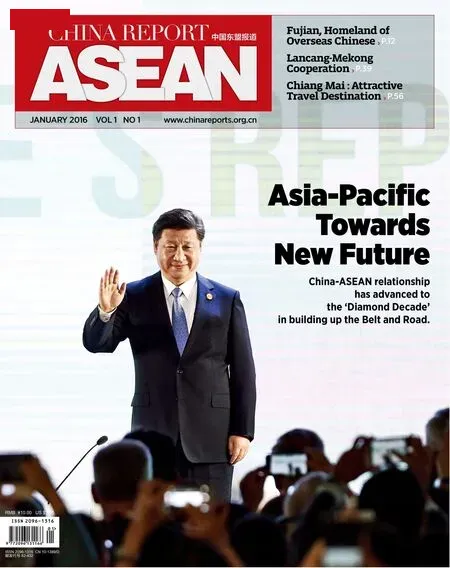ASEAN Economic Community and China-ASEAN Cooperation
By Wang Yuzhu
ASEAN Economic Community and China-ASEAN Cooperation
By Wang Yuzhu
With the end of 2015 approaching,ASEAN is preparing to welcome the fulfillment of the ASEAN Economic Community (AEC). The building of AEC,which started more than 10 years ago, is an important stop along ASEAN's internal integration marathon since ASEAN was established in 1967. Te fulfllment of AEC will start a new era of ASEAN integration with an impact on its economic relationship with dialogue partners. As ASEAN's biggest trading partner, China needs to prepare for this change.
Retrospect of AEC
ASEAN started their intention to establish the AEC in 2003, with the publishing of the“Declaration of ASEAN Concord II” in Bali,Indonesia. The deadline of AEC was originally set on 2020, but no concrete progress was made until ASEAN leaders adopted the“ASEAN Economic Community Blueprint” in 2007 during the 13th ASEAN Summit. After that, ASEAN leaders signed the “Declaration on the Roadmap of the ASEAN Community(2009-2015)” to promote the realization of AEC in 2009. The Declaration presented the strategic vision, specific aims and action plan for the establishment of the ASEAN Community by 2015.
In 2012, ASEAN conducted an interim assessment of the progress toward the building of the Economic Community. Te report recommended that ASEAN should focus on some targets before 2015, while leaving some targets to be realized in the post-2015 era. Although facing challenges, ASEAN decided to bring in the AEC in 2015. In order to give his member countries more time to do homework, the leaders decided in 2012 that the ultimate deadline of the ASEAN Community formation was December 31,2015.
Prospect of AEC
The “ASEAN Economic Community Blueprint” told us that the community aimed at increasing regional integration of ASEAN members in four major areas. Te frst one is the single market and production base, and these will come with the realization of the following core aspects: the free fow of goods,services, investment, capital and technical labor. Second, efforts will be made in shared policies for competition, consumer protection,intellectual property, infrastructure development, taxes and e-commerce to support the formation of a competitive economic zone. Tird, it will promote balanced economic development, and focusing on the development of SMEs, narrowing the development gap around the region. Fourth, by making ASEAN members more active and competitive in the regional production network and global value chain, and by making ASEAN's internal market more attractive to external investment, the AEC will bring the region into global economy. But we should never forget that AEC is a cooperative arrangement by developing countries in Southeast Asia, although the idea of the community might be inspired by or copied from the European Union. ASEAN has to obey the “ASEAN Way” and keep fexibility when promoting AEC. According to the latest ASEAN Foreign Minister Meeting, ASEAN fully implemented 458 of the measures necessary to the establishment of AEC between 2008 and March 31, 2015. Tariff has been eliminated for 95.99 percent of the trading goods among ASEAN members. Even with impressive progress, some experts are not optimistic to AEC, they are worried that ASEAN has problem to meet the targets by the end of 2015. In this sense, they are right, because ASEAN has to leave some tasks for the post-2015 before the AEC can be established by the end of 2015. But from the perspective of ASEAN integration, a discounted AEC is still a success for ASEAN, and it can serve as a new starting point for further eforts towards a more mature economic community.
AEC and China-ASEAN cooperation
Over the past two decades, China and ASEAN have become the most important trading partners to each other. Bilateral trade between China and ASEAN is expected to exceed $500 billion this year, and there is a mutually agreed target of $1 trillion for 2020. To fulfill this target, the two sides need to innovate their bilateral cooperation model to integrate China-ASEAN economy. And that is why the AEC is important not only to ASEAN, but also to China.
To promote its bilateral relationship with ASEAN, China has initiated a “2+7”framework that includes both economic and security cooperation projects. These new projects will contribute to China-ASEAN cooperation, but without the further progress of AEC, their effectiveness may be limited when facing an integrated ASEAN. So, China should help ASEAN to make real progress on its economic community building. One of the urgent issues is to narrow the development gap among ASEAN members,because this is a main hurdle to ASEAN integration. The Belt and Road Initiative should be a main framework for China making contribution in ASEAN's development gap narrowing. Te connectivity that the Belt and Road Initiative highlights will provide infrastructure the less developed ASEAN members needed desperately, and link these countries to global value chain and benefit from regional and global integration. In November,2015, the Lancang-Mekong sub-regional cooperation kicked of with the frst foreign ministers' meeting held in Yunnan, China. This initiative, which focuses on cooperation of Lancang-Mekong sub-region, will be an effective mechanism to promote economic development of the less developed ASEAN members. In other words, AEC will go on, and China is joining in with new initiatives.
About the author:
Wang Yuzhu, Senior research fellow, National Institute of International Strategy, CASS

